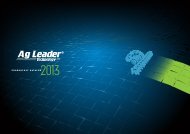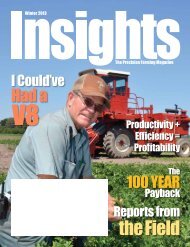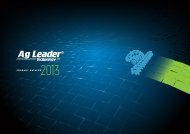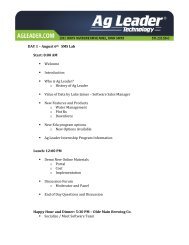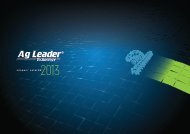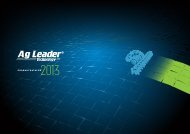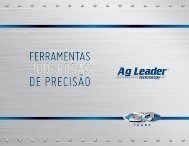Create successful ePaper yourself
Turn your PDF publications into a flip-book with our unique Google optimized e-Paper software.
“If a farmer were upgrading equipment just to get newtechnology, then adding aftermarket precision technologymight be a good idea.”There’s a certain satisfactionin stretching a dollar. Evenwhen times are good forproducers and their families,keeping a watchful eye onexpenses is just good business.Today, producers are doing justthat. Faced with the choice ofbuying new equipment loadedwith new technology or addingthe precision technology to oldermachinery to improve yield andefficiency, producers must decidewhich option is best. Accordingto ag technology experts, itall depends on a number offactors. Randy Taylor, professorand extension ag engineer,Biosystems and <strong>Ag</strong>riculturalEngineering, Oklahoma StateUniversity, says his perceptionis that most farmers tend tobuy new equipment when timesare good, because it has toget them through when timesare hard. They also buy newequipment when older machinesare worn out; when dealers/manufacturers offer incentives;because they are on a regulartrade-in schedule, or for taxpurposes (when times are good).Still, others believe aftermarketsolutions are a clear choice.“If a farmer were upgradingequipment just to get newtechnology, then addingaftermarket precision technologymight be a good idea,” he says.“It depends on the state of theequipment. For example, if I wantsection control on my planter, itwould be less expensive to add itthan buy a new planter with thatoption. However, if my planter isnearing the time when I wouldtrade (wearing out), I shouldprobably go ahead with the newplanter,” Taylor says.For dealers, knowing when torecommend a new machineversus an aftermarket solutionis a judgment call — and onebest made when they know thecustomer. While every produceris different, understanding thecustomer’s mindset about thisissue and whether or not they arein a position to buy new machineryis an important first step.Brian Emmendorfer, generalmanager of St. Joe Tractor, aNew Holland and Kinze dealerin St. Joseph, Missouri, says 80percent of his precision technologybusiness involves the aftermarketsale and installation of <strong>Ag</strong> <strong>Leader</strong>products. Emmendorfer says hiscustomers often seek a retrofit oraftermarket factory installationto reduce seed and fertilizercosts. Last spring, for example,Emmendorfer says excessivewinds from a storm ruined thestand that growers had planted inend rows, resulting in significantlosses. That event, alone, spurredeven more interest in addingprecision ag technology, he says.“If a grower doesn’t have themeans to trade up, they’ll oftenadd precision ag technology,”Emmendorfer says. “But wetake a number of things intoconsideration when discussingwhether to trade up or add on,including the age of the combine,tractor or planter, the precisionag technology options they areinterested in, whether we have aused piece of equipment alreadyavailable with the technologythey’re looking for and whetherthe cost of adding it on would bemore or less than the cost to buyused equipment.”Costs will vary, of course.For example, with advancesin technology, Emmendorfersays the cost to add point rowclutches to an eight-row Kinzeplanter averages $16,000 versusthe cost of a new Kinze planterand the cost of adding the pointrow clutches, since they do notcome factory installed on newmodels. That option could costa grower $70,000.“In this instance, adding the pointrow clutches to an older Kinzeplanter makes sense. And it willpay for itself in two to three years,”Emmendorfer says.Bill Ongstad, a Harvey, NorthDakota, farmer, has had fourof his 20-year-old combinesretrofitted with precision agtechnology. Ongstad, 61, and hisson grow mostly pinto beansand wheat with some corn andsoybeans on their 6,000-acrefarm. They purchased used JohnDeere 8820s, the newest of whichis a 1988 model, and installed <strong>Ag</strong><strong>Leader</strong> yield monitors on two ofthe combines a few years ago fora total cost of $8,000. The cost topurchase a new combine at thetime, Ongstad says, would havebeen around $200,000.“We felt we really needed theyield monitors because theyallowed us to collect importantdata for use in making decisions,”Ongstad says. “I know our dealerwants to sell combines, but theyunderstand that it’s not alwayspossible for us to buy new.”According to Ongstad, retrofittingtwo of his combines with yieldmonitors improved his yield by 10percent and reduced the amountof fertilizer he used by 10 percentsince he knew where to apply it.Despite the current “good times”for some growers, buying newmachinery just doesn’t matchtheir current business andfinancial planning, especiallyfor those who know commodityprices are ever changing. As such,considering aftermarket optionsis just good business, says AdamGittins, precision ag manager forHeartland <strong>Technology</strong> Solutions’(HTS) Precision <strong>Ag</strong>ricultureDivision in Harlan, Iowa.“In almost all instances, it makessense to consider aftermarketprecision ag if you’re strictly tryingto upgrade the technology,” Gittinssays. “<strong>Ag</strong> <strong>Leader</strong> does a goodjob of being color blind, makingprecision ag products that fit justabout any brand. For example, wecan put a yield monitor on everyJohn Deere combine from the late1970s and newer. We can installauto steer on tractors from the1990s on and install precision agtechnology on planters from thelate 1970s and early 1980s. That’swhy they are our primary vendor.”In rare instances, HTS can installprecision technology from <strong>Ag</strong><strong>Leader</strong> that OEMs have not yetincluded from the factory on newfarm equipment. In 2011, forexample, <strong>Ag</strong> <strong>Leader</strong> introducedOptRx crop sensors, whichmeasure and record data aboutcrops in real-time using thereflectance of light shone on thegrowing plants. The data, in turn,is used for real-time variable-rateapplications of nitrogen based onplant vigor. In the end, says Gittins,it’s all about spending money tomake money.“If a grower is content with themachine they have, there’s reallyno compelling reason to upgradeto new equipment. But addingprecision technology will make youmoney!” Gittins says.Summer 2012 | Insights Magazine | 9



